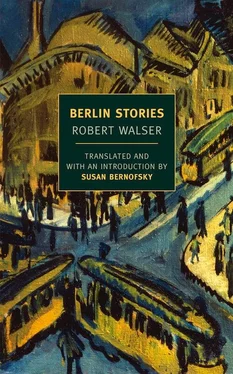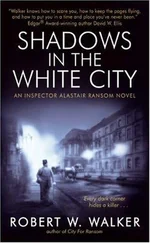Robert Walser
Berlin Stories
The young Swiss writer Robert Walser moved to Berlin in the summer of 1905, at the age of twenty-seven. He’d just published his first book, the outlines of a successful literary career were beginning to unfold before him, and the moment seemed ripe to leave behind the relative peace and safety of his native land for the stimulation and excitement of the German capital. Then as now, Berlin was the destination of choice for young German-speaking writers eager to tap into the pulse of the avant-garde, and his brother Karl, who’d made the move several years before and quickly established himself as the city’s foremost stage-set designer, had been encouraging Robert to join him. Karl’s celebrity secured his younger brother entry into the most exclusive artistic circles, where he met actresses and painters, theater directors and publishers, some of whom took an interest in him.
Berlin in those days was hopping. The city had undergone a period of intense growth in the final decades of the nineteenth century — its population swelled to two million by 1900—and was the site of one of the liveliest high societies in Europe. While factories had bred slums in the city’s northern and eastern districts, the elegance of several of its neighborhoods rivaled that of Paris, though Berlin was more densely packed than the French capital with its brightly lit Grands Boulevards . But Berlin had splendid avenues of its own: Unter den Linden to the east, lined with a double row of the linden trees it was named for, and the swank Kurfürstendamm to the west, as well as a capacious park called Tiergarten, a former hunting ground full of well-tended serpentine paths for Sunday strolls. Potsdamer Platz, Berlin’s busiest intersection (and the one Curt Bois reminisces about in Wim Wenders’s Wings of Desire ), was a tangle of pedestrians, horse-drawn carriages, automobiles, omnibuses, and electric streetcars; by 1908, thirty-five streetcar lines stopped here. Subway cars began to run in 1902, two years earlier than in New York, and people hurried in and out of newfangled restaurants designed for rapid service, like those of the Aschinger chain Walser writes about in two of the stories included here. At Aschinger, one ate standing up, and unlimited free rolls were served to anyone buying a beer. The city’s headlong dive into modernity soon became its trademark. Walser’s acquaintance Walther Rathenau — who later would become foreign minister of Germany — quipped that Berlin’s oldest palaces dated to the early Wilhelmine period, i.e., the late nineteenth century, and dubbed Berlin “Parvenupolis.”
Among Berlin’s would-be parvenus were any number of young artists. The city appeared to reward youthful rebelliousness. Its philharmonic orchestra was formed in 1882 when a group of musicians broke away from the ensemble at a music hall that provided military-band-style entertainment along with ham sandwiches; they moved into a renovated roller-skating rink and soon began performing a repertoire that included Brahms, Wagner, and the young composers Felix Weingartner and Richard Strauss. In the visual arts it was no different: a group of artists removed themselves from the official Association of Berlin Artists in 1892 after the association succumbed to pressure from Kaiser Wilhelm to shut down a show featuring Edvard Munch. The Berlin Secession, as this group soon dubbed itself, quickly rose to prominence and included such luminaries as Max Liebermann, Lovis Corinth, Max Beckmann, Max Slevogt, Walter Leistikow — and Karl Walser. Robert Walser himself served as secretary to the Secession for several months in 1907, as he reminisces in his story “The Secretary.” There were theaters everywhere (their number swelled to thirty-seven by the 1920s), not to mention the many variety shows and cabarets for which the city was to become famous.
Walser had been to Berlin before, twice in fact: in 1897 as a lad of nineteen, and again in 1902; but each time he had fled back to Zurich after only a few weeks, in large part because he felt he would be unable to support himself as a writer in the German metropolis. In 1905, though, he held out for nearly three months before traveling back to Zurich, and after only a few weeks there found himself missing the bustle and excitement of the city so much that he returned, overflowing with newfound optimism. In a note to a friend in Biel, he wrote, “I’m about to write so much that Hesse and Co. will be terrified.” Berlin was to be his home for more than seven years, and the books he wrote here firmly established him as one of the most singular and original voices of European modernism.
For Karl Walser, 1905 was a watershed year. He had recently begun a series of collaborations with the era’s most famous theater director, Max Reinhardt, and in January they put on A Midsummer Night’s Dream together at the Theater am Schiffbauerdamm. In November a grand new opera house, the Komische Oper, opened its doors with a Reinhardt production that one prominent reviewer dubbed “The Tales of Hoffmann — A Walser Dream.” Karl’s stage sets were fanciful, mysterious, and full of romantic gardenscapes and hanging trees, images that also appeared in the paintings he exhibited at Berlin Secession shows. That year he drew the cover illustration for Christian Morgenstern’s collection of humorous poems Gallows Songs , and the book became a surprise best seller. In the middle of the summer, just as Robert Walser was on his way back from Switzerland, Karl packed up his paints and brushes and set off for the elegant neighborhood of Grunewald at the wooded edge of town, where Samuel Fischer, one of the most powerful publishers in Germany, had hired him to paint a series of frescoes in his freshly renovated villa.
For Robert Walser, his brother’s heady rise to fame and fortune must have been as overwhelming as it was unexpected. After all, his brother — only one year his senior — had himself arrived in Berlin penniless, an unknown provincial with a thick accent and inexperienced in the rituals of high society. But while Karl was able to swim with ease in the waters of Berlin’s beau monde , it soon became clear that his social circles were only partially permeable to the younger Walser brother. Robert, who was living as a guest in Karl’s apartment in the tony Charlottenburg district, soon developed a reputation as a big drinker and a sometimes too enthusiastic prankster. He walked up to Hugo von Hofmannsthal in a restaurant and asked the celebrated dramatist, “Can’t you forget for a bit that you’re famous?” Robert and Karl once teased Franz Wedekind — for whose Spring Awakening Karl designed the sets — so persistently that Wedekind fled a dinner party to escape them, only to get stuck in a café’s revolving door, where the brothers cornered him once more, shouting “Schafskopf!” (muttonhead) as he whirled past.
In a letter to their sister Fanny, Robert describes his attempt to assimilate to his elegant new surroundings and social life:
So little soup was served that afterwards the vegetables and the roast meat were doubly appealing. After lunch I passed the hours gazing at myself in four beautiful mirrors that were hung up in the blue living room, and yet came no closer to making sense of myself — on the contrary, I became stupider and stupider. Then I went calling and always returned home famished. You had to take the train, and that was splendid. I grew accustomed to hackney cabs, waiters, and refined ladies. I wore an elegant, long, black, close-fitting frock coat, a vest, silver-blue in color, trousers that didn’t fit so well, a tall hat and a pair of gloves balled up in my hands. I looked magnificent, for a coat like this makes one a human being. But I resolved to remain an honest man, and so I threw off these dainty coverings. I packed my miserable carpenter’s bag and sailed off.
Читать дальше












